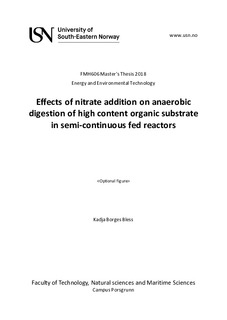| dc.description.abstract | Biogasification can recover a significant portion of energy potential from organic wastes. In addition to energy recovery, it also offers waste stabilization. However, there is a need for more efficient process for digestion of organic matter, resulting in higher methane yield. The main objective of the present experimental research is to test the enhancement of methane production in anaerobic digestion continuous flow stirred tank reactors (CSTR) through addition of limited amounts of nitrate. The hypothesis that such method can enhance hydrolysis has been previously suggested, and the mechanisms by which this process may occur is studied. Feedstock with high fat content, composed of primary sludge, fish oil, food waste and septic, pretreated by thermal hydrolysis was used as feed in several intermittently fed CSTR. Digestate from the full-scale plant at Lindum, Drammen, treating the same feed, was used as inoculum. Gas production rate was slightly higher during the period when nitrate was introduced to the anaerobic reactors. The effect of nitrate addition could be more evident in systems with higher concentration of proteins and carbohydrates in the feed since theory suggests that nitrate will not influence fat digestion much. Nitrate addition improved environmental conditions in the reactor as lower variations in VFA and total alkalinity was observed in reactors supplied with nitrate compared to solely anaerobic reactors. The initial amount of nitrate added to the system must be low enough to trigger nitrate reducing microorganisms, without leading to losses in methane production. In the present case study, the recommended initial amount is 0.1 % nitrate of equivalent feed COD. Furthermore, it is estimated that nitrate could be added up to an amount of 0.5 % COD, without effecting gas production negatively. When imposing a load increase, the response time for reactors supplied with nitrate was slower than for reactors without nitrate. However, the methane yield that stablished after ¼ hydraulic retention time with high load was higher for reactors with nitrate (0.175 % equivalent COD) than for those running solely anaerobically. Further studies on the long-term effects of nitrate on anaerobic digesters should focus on mechanisms and effects on the microbial populations. For industrial application, nitrate can be added directly to the anaerobic reactor and the process should be carefully monitored by using measurements of methane production and COD estimation for feedforward and feedback control. | nb_NO |
